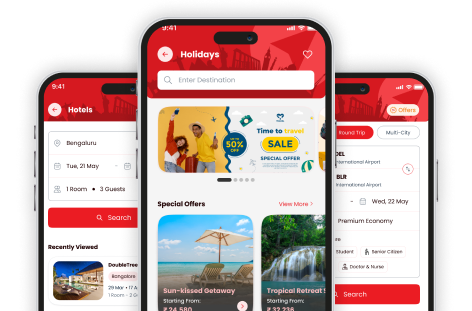Quick Facts
Full country name: Republic of Mauritius
Area: 1860 sq km (725 sq mi)
Population: 1.2 million
Capital City: Port Louis (pop 150,000)
People: Indo-Mauritian (68%), Créole (27%), Sino-Mauritian (3%), Franco-Mauritian (2%)
Languages: English, Créole, French, Hindi, Urdu, Hakka, Bojpoori
Religion: Hindu (51%), Christian (30%), Muslim (17%)
Government: Parliamentary democracy
President: Karl Offmann
Prime Minister: Navinchandra Ramgoolam
GDP: US$11.7 billion
GDP per head: US$10,300
Annual Growth: 5%
Inflation: 6%
Major Industries: Sugar, textiles, tea, tobacco, tourism
Major trading partners: EU, US, South Africa, India
Country Facts
Events:
January: Teemeedee, a fire-walking ceremony held in honor of various Hindu gods.
February: Thaipoosam Cavadee at temples throughout the island. Hindu devotees skewer their tongues and cheeks in homage to the second son of Lord Shiva.
March: Maha Shivaratri, when most of the island’s Hindu population makes a pilgrimage in honor of Lord Shiva to the holy volcanic lake Grand Bassin.
September: Père Laval Feast Day marks the anniversary of the Catholic convert-king’s death, and pilgrims come from all over the world to his shrine at Ste-Croix to pray for miracle cures.
Currency:
Mauritian rupee
Traveler’s cheques in any major currency can be exchanged without a hitch in Mauritius – and they bring a better rate of exchange than cash. The government sets the exchange rates, so there is no need to check out rates at various banks. Credit cards are widely accepted, with cash advances available from most major banks.
Beaten Track:
Black River Gorges National Park
About 6 km from Curepipe, Mauritius’ only mountain road reaches the dam wall of the park’s large reservoir, Mare aux Vacoas. It is surrounded by casuarina and coniferous trees. About 6 km southeast of Mare aux Vacoas is the sacred lake of the Hindus, Grand Bassin, and, a few kilometers farther east, Plaine Champagne, the rainiest spot and largest natural area on Mauritius. Toward the eastern end of the plain, the Rivière Noire overlook affords spectacular views of waterfalls.
Rodrigues Island
A volcanic island 18 km long and 8 km wide, Rodrigues is in many way a miniature Mauritius. It’s surrounded by coral reefs, covered with similar vegetation and landscapes, and blessed with an equally tropical climate. Rodrigues isn’t quite as lush as Mauritius, but neither is it thick with tourists. The pace of life is more relaxed and the people prone to stop and chat.
The island is relatively small and perfect for rambling around at leisure. Hiking is good around Mt Limon and Mt Malartic, the island’s two highest points. The best coastal hiking leads from Port Mathurin around the eastern coastline to Port Sud-Est. Point Coton on the eastern coast has the best beach on the island, but there are other good ones at St François, Trou d’Argent and Petit Gravier. Rodrigues lies about 560 km northeast of Mauritius. The two islands are connected daily by air and several times per month by sea.
History:
Portuguese naval explorers stumbled upon Mauritius in the wake of Vasco de Gama’s voyage around the Cape of Good Hope in 1498. But the Portuguese did little to influence the island. This was left to the next wave of immigrants, the Dutch. In 1598, Vice Admiral Wybrandt van Warwyck came ashore and claimed the island for the Netherlands, christening it after his ruler, Maurice, Prince of Orange and Count of Nassau. The colony, however, never really flourished, and the Dutch departed for good in 1710, leaving in their wake the extinction of the dodo and the introduction of African slaves, Javan deer, wild boar, tobacco and sugar cane.
Five years later, French captain Guillaume Dufresne d’Arsal claimed the island, renamed it ale de France and gave it over to the French East India Company to run as a trading base. Popular settlement began in 1721, and within 15 years the first sugar mill had been built, along with a road network and hospital.
During the second half of the 18th century, the island’s capital, Port Louis, became a free trading base and haven for corsairs – mercenary marines paid by a country to plunder the ships of its enemies. Tired of the competition, the British moved in on the corsairs (and on Mauritius) in 1810. After an initial defeat at the Battle of Vieux Grand Port, the Brits landed at Cap Malheureux on the northern coast and took the island. The 1814 Treaty of Paris ceded ale de France, Rodrigues and the Seychelles to the victors but allowed Franco-Mauritians to retain their language, religion, Napoleonic Code legal system and sugar plantations. In 1835, the slaves were freed and the labor force was supplemented by workers brought in from China and India.
While the Franco-Mauritian plantations produced wealthy sugar barons (as they do today), Indian workers continued to be indentured by the thousands. Through strength of numbers, Indians gradually bolstered their say in the country’s management, aided in 1901 by a visit from Mahatma Gandhi. In 1936, the Labor Party was founded to continue the struggle for laborers’ rights. The following year, their burden was lightened by a new constitution granting the vote to anyone over 21 who could sign their name. Under the direction of Dr Seewoosagur Ramgoolam (who was later knighted), membership swelled and the party flourished.
Mauritius was granted independence from Britain on March 12, 1968, and Sir Ramgoolam was elected prime minister, a title he retained for the next 13 years. He was succeeded by a coalition of the leftist Movement Militant Mauricien (MMM) and the Parti Socialiste Mauricien, though tensions in the parties’ upper ranks rattled the infrastructure throughout their reign. In 1986, three Mauritian MPs were caught at Amsterdam’s airport with heroin in their suitcases, and the resulting inquiry implicated other politicians in drug money and led to several resignations. Mauritius officially became a republic in 1992. Sir Ramgoolam’s grandson, Navin Ramgoolam, won the elections in 1995 and led the country in its pursuit of prosperity until September 2000, when new elections were won by an alliance of the Socialist Militant Party and the Militant Movement.
Tensions between the Creole population, descended from former slaves, and the Indo-Mauritian majority, exploded in 1999. Popular reggae singer Joseph ‘Kaya’ Topize was arrested during a rally to legalize marijuana and died of a skull fracture while in police custody. Riots broke out across the island, particularly in Port Louis.
Culture:
Over half the population of Mauritius is Hindu and roughly another fifth is Muslim. Both groups descend from laborers brought to the island by the British to work in the cane fields. While some of the resident Chinese and Sino-Mauritians were also brought over as laborers, most came to Mauritius as entrepreneurs, and many still control the lion’s share of village-based commerce. The remaining population is composed mainly of Craoles, descendants of African slaves, and Franco-Mauritians, the original settlers of the island. Franco-Mauritians, who make up about 2% of the population, still control many of the. sugar plantations, although many emigrated to South Africa and France following independence
English is the official language of the island, though you’re bound to hear French, Craole (a melange of French and various African dialects) and a smattering of Indian languages. The island’s main contribution to the performing arts is the Craole saga, a foot-shuffling, body-gyrating, downright erotic dance that’s generally performed on the beach to the rhythm of Latin American, Caribbean and African pop.
One highlight of a visit to Mauritius is the magnificent mixture of cuisines on offer. The most common varieties are Craole, European, Chinese and Indian, with seafood almost always the specialty. In addition, a typical Mauritian buffet might include a Muslim biryani, Indian chicken curry, Chinese pork dish, Craole roast beef and French-style vegetables. Boiled rice is served with just about everything.
Environment:
Mauritius is a volcanic island, measuring 58km from north to south and 47km from east to west – about two-thirds the size of Luxembourg or the US state of Rhode Island. It lies in the Indian Ocean, roughly 800 km east of Madagascar, 3860 km south-west of India and 220 km north-east of its nearest neighbor, Raunion. With about 600 people per square kilometer, Mauritius has one of the highest population densities in the world.
The island rises steeply in the south to a central plateau and slopes gently down to the northern coast beyond the mountains that back the capital, Port Louis. Unlike neighboring Raunion, Mauritius has no active volcanoes, although remnants of volcanic activity – such as Trou aux Cerfs crater in Curepipe and millions of lava boulders – pepper the island. Mauritius is surrounded by a coral reef and lined by a few long stretches of white sand beach.
The last decade has seen Mauritian conservationists scrambling to protect the paltry 1% of original forest remaining on the island. The largest nature reserve is the Black River Gorges National Park at the south-western end of the island. Other reserves include Le Pouce, ale Ronde, ale aux Serpents, ale aux Aigrettes and Bois Sec. Visitor access is (or will be) restricted at many reserves, as most are tiny in size and enclose the last vestiges of rare species.
Mauritius’ trees and skies are rich with birdlife, although many of the most spectacular species are following in the footsteps of the island’s most famous one-time resident, the dodo. On the endangered species list are the Mauritius kestrel (once the rarest bird on earth), the echo parakeet (still the rarest of that species) and the pink pigeon.
Getting There:
Tourists to Mauritius fly into the country. You must have a return or onward ticket before arriving in Mauritius. Cargo ships ply the Indian Ocean regularly, though few take passengers. You’re more likely to find passage on the private yachts that call in at Mauritius outside of cyclone season, berthing at Grand Baie or Port Louis. Still, opportunities are rare. About the only guaranteed way to come or go by sea is to book fare on the MV Mauritius Pride, which cruises several times a month between Mauritius and Raunion, or to board one of the cruise liners that periodically drops anchor in Port Louis.
Getting Around:
Sir Seewoosagur Ramgoolam International Airport is near Mahabourg in south-eastern Mauritius. There are no direct airport buses but express buses run between the capital and Mahabourg several times a day, stopping at the airport. Mauritian buses can carry you to nearly any place on the island. There are several different operators, none of which cover the entire island. Port Louis and Curepipe are the main hubs. Driving is on the left. Bicycles and boats can be rented wherever tourists congregate.
When To Go
With less rain and humidity, July to September is the best time to visit. Weather wise, the least agreeable period is from January to April, when the long days can prove too hot and humid for some and the threat of cyclones is in the air. December through March is the best time for diving, when the waters are at their clearest.
Explore Attractions
Port Louis
Even though it is the capital city, Port Louis contains a relatively small percentage of the country’s total population. During the day, it bustles with big-city commercial activity but by night all is quiet. At the Le Caudan Waterfront, you’ll find a casino, cinemas, shops, bars and restaurants. There’s a distinct Muslim area around Muammar El Khadafi Square and a Chinatown around Royal St. The city center is easily covered on foot.
The Port Louis Market, near the water in the heart of downtown, is a good place to get a feel for city life. It has sections devoted to fruits and vegetables, meats and fish, souvenirs, crafts, clothing and spices. While in the neighborhood, most visitors drop by the Natural History Museum to see a stuffed replica of that ‘abnormal member of a group of pigeons’, the dodo, which has been extinct since the late 17th century.
Activites
Many hotels provide windsurfing and kayaking equipment. For those who prefer less strenuous communing, there’s usually a glass-bottom boat to be found. For Jules Verne fans, lead-booted, bubble-headed ‘undersea walks’ can be arranged near Grand Baie reef.
The area around Tamarin is said to be the best spot for surfing. The season lasts from around June to August. Diving around the island is not especially interesting, except for the outer isle of Cargados Carajos. Snorkeling is a better proposition, with boat trips running from most major hotels and from Grand Baie beach. The best swimming beaches are all at the northern end of the island.
Serious anglers will love the superb deep-sea fishing in the waters off Mauritius, where there are healthy populations of blue and black marlin, bonita and yellowfin tuna, several species of shark and spectacular sailfish to hook into. There are also attractions of hiking and trekking through the interior. For lowland walking, take into account the heat and humidity.
Visa
Mauritius TOURIST VISA REQUIREMENTS
FOR INDIAN NATIONAL Mauritius VISA IS GRANTED ON ARRIVAL. VISA IS GIVEN FOR 15 DAYS. PAX NEEDS TO CARRY FOLLOWING DOCUMENTS.
Valid passport for 6 months from date of return from Mauritius with minimum two blank pages.
Conformed return air ticket and hotel confirmation
Foreign Exchange USD 50 per day minimum so multiply by number of days
No Visa Fees for on arrival visa
Time: Mauritius is 1 1/2 hrs behind India
Electricity:220V or 125V, 50 Hz






